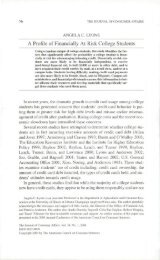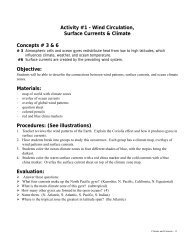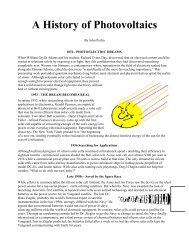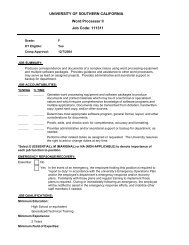Create successful ePaper yourself
Turn your PDF publications into a flip-book with our unique Google optimized e-Paper software.
• Like the Eukarya, they have membranes composed <strong>of</strong> unbranched fatty acid<br />
chains attached to glycerol by ester linkages.<br />
• The cell walls <strong>of</strong> Bacteria, unlike the Archaea and the Eukarya, contain<br />
peptidoglycan.<br />
• Bacteria are sensitive to traditional antibacterial antibiotics but are resistant to most<br />
antibiotics that affect Eukarya.<br />
• Bacteria contain rRNA that is unique to the Bacteria as indicated by the presence<br />
molecular regions distinctly different from the rRNA <strong>of</strong> Archaea and Eukarya.<br />
Bacteria include mycoplasmas, cyanobacteria, Gram-positive bacteria, and Gramnegative<br />
bacteria.<br />
3. The Eukarya (eukaryotes)<br />
The Eukarya (also spelled Eucarya) possess the following characteristics:<br />
• Eukarya have eukaryotic cells.<br />
• Like the Bacteria, they have membranes composed <strong>of</strong> unbranched fatty acid<br />
chains attached to glycerol by ester linkages (see Fig. 1).<br />
• Not all Eukarya possess cells with a cell wall, but for those Eukarya having a cell<br />
wall, that wall contains no peptidoglycan.<br />
• Eukarya are resistant to traditional antibacterial antibiotics but are sensitive to most<br />
antibiotics that affect eukaryotic cells.<br />
• Eukarya contain rRNA that is unique to the Eukarya as indicated by the presence<br />
molecular regions distinctly different from the rRNA <strong>of</strong> Archaea and Bacteria.<br />
The Eukarya are subdivided into the following kingdoms:<br />
a. Protista Kingdom<br />
Protista are simple, predominately unicellular eukaryotic organisms.<br />
Examples includes slime molds, euglenoids, algae, and protozoans.<br />
b. Fungi Kingdom<br />
Fungi are unicellular or multicellular organisms with eukaryotic cell types.<br />
The cells have cell walls but are not organized into tissues. They do not<br />
carry out photosynthesis and obtain nutrients through absorption. Examples<br />
include sac fungi, club fungi, yeasts, and molds.<br />
c. Plantae Kingdom<br />
Plants are multicellular organisms composed <strong>of</strong> eukaryotic cells. The cells<br />
are organized into tissues and have cell walls. They obtain nutrients by<br />
photosynthesis and absorption. Examples include mosses, ferns, conifers,<br />
and flowering plants.<br />
d. Animalia Kingdom<br />
Animals are multicellular organisms composed <strong>of</strong> eukaryotic cells. The cells<br />
are organized into tissues and lack cell walls. They do not carry out<br />
photosynthesis and obtain nutrients primarily by ingestion. Examples include<br />
sponges, worms, insects, and vertebrates.



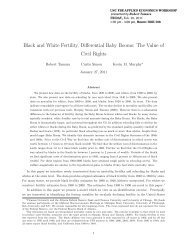

![15. RS 1.003 (RaJsu-yeni - nql?) RS 18.056 (RaJsu-yeni -5'[ ... ])](https://img.yumpu.com/51622603/1/189x260/15-rs-1003-rajsu-yeni-nql-rs-18056-rajsu-yeni-5-.jpg?quality=85)
